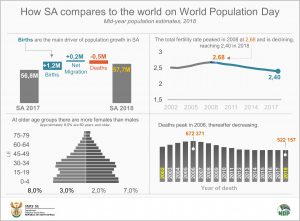World Population Day: How does SA compare?
By mid-2018, according to the Mid-year population estimates released by Stats SA, South Africa’s population stood at 57,73 million people, which is less than one per cent (0,75%) of the total world population. According to the UN, the total world population is estimated at 7,7 billion people in 2019 and will exceed 8 billion by 2030.
World Population Day, first observed in 1989 when the world population reached 5 billion, is observed every year on 11 July. The aim is to focus attention towards growing global issues in a rapidly expanding global population. While the 2019 theme focuses on the youth, we take a look at how SA compares to the rest of the world.
According to the United Nations, global population growth has been driven by changing fertility rates, improved life expectancy, urbanisation and migration.
Births were the main driver of population growth
In 2018, births were the main driver of population growth in South Africa. More than 1,2 million births were recorded, and survival rates among infants and children under-5, and post-HIV interventions have increased. The infant mortality rate (IMR) has declined from an estimated 53,2 infant deaths per 1 000 live births in 2002 to 36,4 infant deaths per 1 000 live births in 2018. On average, a woman will give birth to 2,4 children in her lifetime, which is 0,1 lower than the global average of 2,5.
People are living longer
Life expectancy in SA has been increasing since 2007. Between 2002 and 2006, life expectancy at birth declined mainly due to the impact of the HIV and AIDS epidemic, but expansion of health programmes to prevent mother-to-child transmission as well as access to antiretroviral treatment has partly led to the increase in life expectancy since 2007. By 2018, life expectancy at birth was estimated at 61,1 years for males and 67,3 years for females. The global life expectancy as at 2019 is 72,6 years. In South Africa, it stands at 64,2 years, indicating that SA lags 8,4 years behind the global average.
The number of deaths are decreasing
In 2002, the crude death rate (CDR) was 12,6 deaths per 1 000 people. It has since declined to 9,1 deaths per 1 000 people in 2018. The number of deaths recorded was at its highest in 2006, and gradually decreased each subsequent year. At its peak in 2006, the number of recorded deaths was 672 371, while there were 522 157 recorded deaths in 2018. Since 2002, there has also been a decline in the prevalence of HIV amongst youth aged 15–24. The decline in prevalence among youth is an indication of the declining rate of new infections among young people since 2002. According to the UN estimates, the world’s population is expected to increase by 2 billion persons in the next 30 years, from 7,7 billion currently to 9,7 billion in 2050. What will South Africa’s estimates be for 2019? If you would like to find out, Stats SA will be releasing the new mid-year population estimates before the end of July 2019.
For more information on population estimates, download the Mid-year population report here.
References:
https://population.un.org/wpp/
https://www.un.org/development/desa/publications/world-population-prospects-2019-highlights.html


